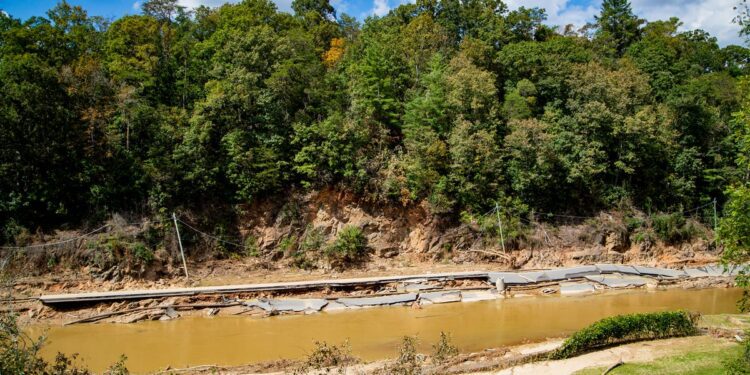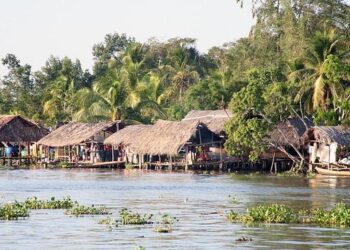Lake Lure damage in North Carolina as seen from above
The Lake Lure area of North Carolina was hit hard by flood waters from Hurricane Helene as shown in this drone footage taken on Oct. 1, 2024.
Reuters
As flooding, wind and landslides from Tropical Storm Helene devastated lives and property across parts of Southern Appalachia, the storm also wrought ecological destruction.Â
Biologists and other experts are still struggling to reach areas of Western North Carolina wrecked by storms to assess the damage. Some are facing the impacts of Helene on their own lives.Â
But as early appraisals of the havoc begin, one outcome is clear: Some stretches of habitat in Western North Carolina could take decades to recover.Â
“What these ecosystems will look like in the next 10 years, 20 years, 50 years, will potentially be drastically different than what it would have looked like if this storm hadn’t happened,” said Falyn Owens, a wildlife extension biologist at the North Carolina Wildlife Resources Commission.Â
“Hurricane Helene has impacted this area in a way that we have not seen yet in recorded history.”
How did Helene affect aquatic habitat?
As turbulent floodwaters tore homes and businesses asunder, huge amounts of sediment were moved along the way.Â
Aquatic habitat is highly sensitive to changes in turbidity, or the amount of particles, like silt, in the water. Floods and landslides reshaped swaths of habitat, and more could be severely damaged by sediment loads.Â
“We definitely anticipate that the biggest, longest-term effects of the hurricane are going to mostly impact aquatic species and aquatic habitats,” Owens said.
“A huge amount of human-made debris has been washed into riparian areas, which will likely cause water quality issues for many months” in Western North Carolina, according to a statement from Miranda Turner, a wildlife health biologist with the Wildlife Resources Commission.
“The severity of the water quality issues will depend on what type of debris and toxicants were released during the storm and how much of them ended up in important wildlife habitats, but the potential impact to fish, amphibians, and reptiles may be extensive.”
Biologists are just beginning to assess the scale of the harm.Â
“It’s going to take a long time, months, if not years, to really understand what the impacts have been for the wide variety of aquatic species that we do track,” Owens said.
The destruction has already befallen the eastern hellbender, for example — a rare salamander, and the largest amphibian in North America — whose critical habitat was devastated by Helene, The Citizen Times previously reported.
And in McDowell County, the North Carolina Wildlife Resources Commission reported “significant damage” to a state fish hatchery.
All 600,000 fish at the hatchery either died or were driven from the hatchery amid the storm, according to spokesperson Anna Gurney.
The facility is closed indefinitely while the commission assesses the damage.
How did Helene affect non-aquatic species?
Deer, raccoons, coyotes and other terrestrial species are more mobile than aquatic species, and are typically better equipped to dodge storm impacts, Owens said.Â
“I’m sure there’s a certain amount of any of those species that did not survive, that got swept into the flooding and drowned,” she said, but “we don’t anticipate big population-level effects on those species.”
Helene also had tremendous influence on various bird species, some of which were in a migratory season.
Some coastal bird species were swept as far inland as Indiana by the storm, according to BirdCast, a project of the Cornell Lab of Ornithology and other collaborators.Â
In late September, as Helene drilled into Western North Carolina, laughing gulls were reported near Asheville, according to displaced species data from BirdCast.Â
“Reports from birders across the country allowed them to see that we had some pelagic birds, which usually are only found on the ocean,” Owens said, “basically caught up in the winds from the storm and swept inland.”
Western North Carolina is also “known to have many species of bats that roost in bridges, including federally endangered gray bats,” according to Turner.
“With the loss of multiple bridges due to flooding, it is unknown whether these roosts and bats survived the storm, and it will take many months for the infrastructure in the area to improve enough that biologists will be able to access these areas to check on the bat populations.”
The fate of many other at-risk species — including the southern bog turtle, Hickory Nut Gorge green salamander, and the Carolina northern flying squirrel — remains unclear after Helene, as experts struggle to reach damaged areas, Turner added.
And amid North Carolina’s changing climate, more damage is on the horizon.
“As climate change worsens and we see more frequent and severe extreme weather events,” Turner said, “we will likely see many more wildlife issues arise caused by the easier spread of disease, animals being forced out of their natural habitats, and increasing human-wildlife interactions as animals try to adapt to changes to their environment after these events.”
How did Helene affect vegetation, crops and forest?
Helene’s destruction left a blank slate in parts of Western North Carolina, clearing trees and vegetation. Those open wounds could offer opportunities for invasive species to gain a foothold.Â
“The ecosystems will reestablish themselves, and we’re going to be worried about invasive species that tend to take advantage of disruptions in these systems,” Owens said. “That might be a battle that we have to fight, more so than we would have otherwise.”
The state will work to recover biodiversity, she said, helping native plants to return and combating the spread of invasives.
Invasive plants tend to push out advantageous native species and cause other negative ripple effects. For example, tree of heaven, a prevalent invasive in North Carolina, is a preferred host of the spotted lanternfly — a destructive, invasive pest already establishing itself in the state.Â
The region’s crop production is also expected to suffer. Thousands of farms and more than $600 million in crop production value sat in Helene’s path through North Carolina, according to an analysis from the American Farm Bureau.Â
“Excessive rainfall and flooding have created perfect conditions for bacterial and fungal diseases to thrive” in vegetable crops, the analysis said, and food crops exposed to floodwaters cannot be sold, per federal regulation.
And landslides could compound ecological damage in the woods blanketing the Southern Appalachian mountains. The events can “wipe out large tracts of forest, destroy wildlife habitat, and remove productive soils from slopes,” research has found.
Pisgah and Nantahala national forests withstood Helene’s wrath for the most part, and have reopened gradually as crews work to clear debris and repair roads and trails, The Citizen Times reported.Â
‘Decades’ until ecological recovery from Helene
As experts assess the damage of Helene, both to human lives and the wildlife of Western North Carolina, certain parts are expected to recover faster than others.Â
“Some species will return quickly,” Owens said. “Some types of plants, some of our aquatic species, they will return quickly.”
But having just one species of plant or animal dominate an ecosystem is a recipe for degradation.Â
A forthcoming challenge for North Carolina’s scientists will be to preserve and nurture the return of biodiversity in damaged areas.
Healing will be a lengthy process.
“In the long run, much of these areas will recover,” Owens said. “But when I say the long run, I mean potentially decades.”
Connor Giffin is an environmental journalist with the USA TODAY Network, reporting for The Citizen Times in the wake of Helene. Reach him directly at [email protected] or on X @byconnorgiffin.
Source link : http://www.bing.com/news/apiclick.aspx?ref=FexRss&aid=&tid=671c3948953a4fcdaa11a6dfd133e5ec&url=https%3A%2F%2Fwww.jsonline.com%2Fstory%2Fnews%2Flocal%2F2024%2F10%2F25%2Fhelene-recovery-habitat-and-ecology-upended-in-western-north-carolina%2F75812096007%2F&c=13607110854287602795&mkt=en-us
Author :
Publish date : 2024-10-25 11:58:00
Copyright for syndicated content belongs to the linked Source.












